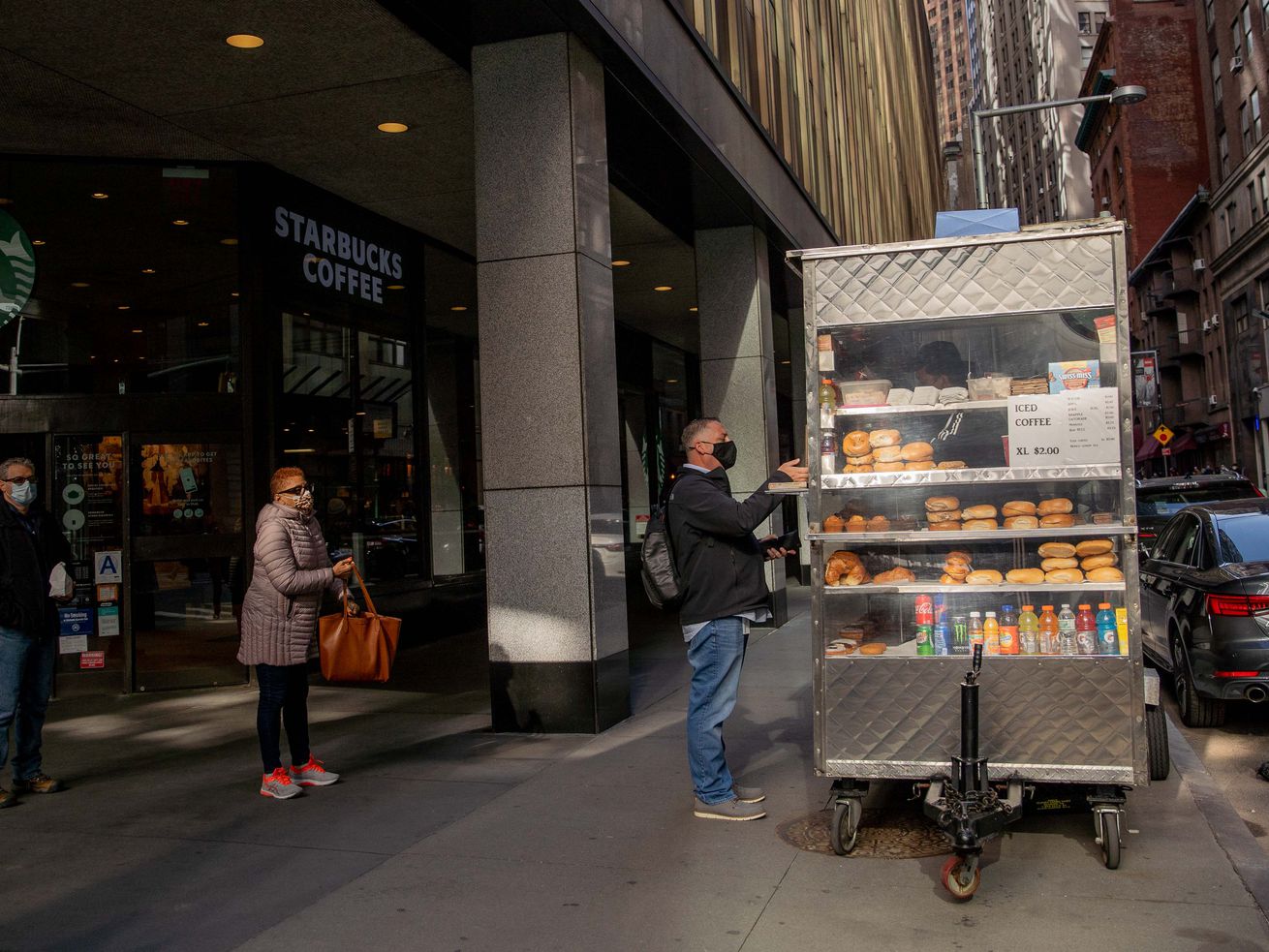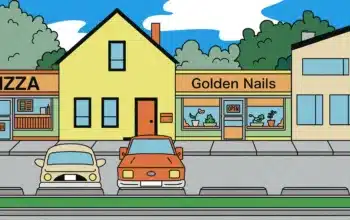Who wins and who loses in the remote work revolution.
When Ozzy Qurbanzada dropped off his coffee cart at a garage at the outset of New York’s Covid-19 outbreak, he thought it would be two weeks before he was back to the spot in downtown Manhattan he’d been selling from for some 25 years. Instead, it would be a year before he decided to go back, and even as the city creeps toward more normalcy, business is nothing like it used to be. It’s expensive to run the cart — his spot at the garage costs $400 a month, plus tolls and gas and supplies — and it’s impossible to plan how much inventory he needs week to week.
“Regular customers, I know what they want, what they get. Right now, I don’t know what I’m going to get or who I’m going to get,” Qurbanzada says. “Every day, I’m guessing.”
The future of Qurbanzada’s business is largely out of his hands. Instead, it’s in the hands of thousands of strangers and whether they return to the office. “When you look out at New York City and all those offices and all those buildings, they are made for people to work, not for people to sit at home,” he says. He wants to know what my plans are. After all, he notes, I work in the area.
There’s a lot of potential good in the rise in remote work. It can provide flexibility, cut down commuting time, and make many workers more productive and happier. But the work-from-home shift has important implications for people who can’t, and many of them are negative. Some of the businesses and workers that have struggled the most over the past 18 months are those that count on business from people who are currently working from home — the local lunch spots, nail salons, coffee shops, office maintenance crews. And as the future of remote work remains in flux, so does the future of some of those in-person positions, at least in their pre-pandemic iterations.
“This revolution in flexibility is not a bad thing,” said Rakeen Mabud, managing director of policy and research and chief economist at the Groundwork Collaborative, a progressive think tank. “But it feels like we’re trading the well-being of the privileged for the well-being of those who work at coffee shops, at lunch counters, that depend on office workers. That’s the inevitable outcome that’s predicated on inequality.”
The pandemic has exacerbated existing divisions in the United States economy in myriad ways, including when it comes to work. Higher-educated, better-paid people are much likelier to be able to work from home than less-educated, lower-paid people, who at the outset of the Covid-19 outbreak were furloughed, laid off, or were declared essential and kept going into work.
According to Gallup, 72 percent of white-collar workers are still working from home at least some of the time as of this spring, while just 14 percent of blue-collar workers are. The Bureau of Labor Statistics estimates that just one in 10 people with less than a high school diploma and one in four people with a high school diploma can work from home. Meanwhile, two-thirds of people with a bachelor’s degree or higher have that option. Black and Hispanic workers are less likely to be able to work remotely than white and Asian American workers.
In other words, when we are talking about the shift to remote work, we are talking about certain people in certain jobs.
“What this does, in many ways, is exacerbate existing class or socioeconomic or racial divides,” Richard Florida, an urban studies theorist, said at a recent symposium on the rise of remote work. “White, professional knowledge workers are many more times more likely to have the privilege of working remotely than minority essential workers.”
And the ability of the former group to stay home has a tangible impact on those in the latter group. Qurbanzada hopes his office customers will be back soon, but it’s hard to know what will happen. “A lot of people got used to working from home, but a lot of people are complaining they’re not happy working from home,” he told me.
A Manhattan microcosm
Manhattan’s financial district has weathered figurative and literal storms in recent decades — the September 11 terrorist attacks, the financial crisis, Hurricane Sandy. But John Moran, the owner of the Killarney Rose, a local bar that’s been in the area since 1968, has never quite seen anything like this. “9/11 and this are totally different, because people weren’t told to stay home after 9/11,” he said. Of the current situation, he said plainly, “It sucks. There’s no businesses down here, there’s no office businesses.”
When I wandered down the largely empty street to interview Moran on a late Monday morning in July, he had begrudgingly decided to close the bar for the day. Being open seven days a week, at least during the summer, wasn’t worth it. He recalled looking around the place at 7 pm the Friday before and counting just seven patrons. Business would pick up later in the evening, but that was because of the young people who live in high-rises in the area, not workers. “I’d give it years before there’s any kind of normalcy in the city, especially down here,” Moran told me. He, too, wanted to get a sense of my job’s back-to-work plan. Did I expect my floor to be full?
According to the Alliance for Downtown New York, which manages the area’s business district, just a quarter of workers in downtown Manhattan’s commercial offices are coming in at least part time. While that’s an improvement from just 10 percent in the depths of the pandemic, it’s a far cry from what it once was. Some companies, such as Goldman Sachs, are asking for their workers to come back full time, while others are opting for a hybrid model or are going fully remote. The future remains highly uncertain: Most remote work plans aren’t set in stone, especially as the pandemic continues to evolve.
“We’re certainly not going back to Monday to Friday, 9 to 5,” said Jessica Lappin, president of the Alliance. Still, she hopes the situation will improve. “I think when the fall comes, it’s that natural kind of shift back into a routine.”
For some businesses, it will be too late. In downtown Manhattan, 75 percent of retail and hospitality businesses in the area were temporarily shuttered in March 2020, and last year, 12 percent of all businesses there — or about 160 — closed their doors permanently. This year, an additional 60 businesses have shut down. Between this year and last, 100 new businesses have popped up as well — the tiny Argentine coffee place I used to buy pastries from sometimes is now a smoke shop — but they’re still not keeping pace.
Moran has managed to stay afloat during the pandemic, and he’s lucky enough to own his building. But it’s still tough. “I’m still working at a loss, and I’d say a lot of other people are, too,” he said.
“It’s going to be very difficult to think that there’s going to be a surge in jobs based on the return to the office, because the return to the office is going to be gradual,” said Mitchell Moss, a professor of urban policy and planning at NYU. “If we don’t have people working five days a week, then we’re going to see a real cutback in workers who support those people.”
Ibrahim, who has had a smoothie cart on Wall Street for about a decade, is among those who is on the brink of giving up. He tried coming back for a couple of weeks over the summer, but there was construction in his typical spot, and he wasn’t making any money. He’s going to try again next month, but for right now, he’s staying at home with his kids and has started to study computer science online — something he’d rather do while working at his cart.
“Because the business is closed, I’m trying to use it for time to help me right now or later. After the pandemic, I wish everything will go back and I can start back my business, because it’s better for me,” Ibrahim said.
The death of the office and the lunch counter?
New York was hit hard and fast by the pandemic. It lost more jobs than any other major US city, and its unemployment rate is nearly double the national one.
“There’s a huge set of people who serve office workers,” Moss said. “They range from selling coffee and lunch to delivering dinners because people work late to … those who shine shoes, those people who do nails, those people who clean the buildings. There’s a lot of maintenance in modern buildings, more than people realize.”
New York is hardly an outlier in undergoing economic turmoil during the pandemic. According to a report from Bloomberg CityLab, 80 percent of Chicago’s public transportation passengers plan to return to that mode of transportation, and San Francisco transit authorities don’t think ridership will reach the levels they were at before the pandemic until at least 2024. One recent poll found that one-third of Bay Area residents say they’ll commute to work less after the pandemic.
America’s reality is one of a segregated workforce and economic rifts. In many parts of the country, the activities of more well-off people — whether or not they go to the office, out to eat, or on vacation — directly impact the economic prospects of often lower-paid people who work in the service sector or other interconnected areas.
Jed Kolko, chief economist at Indeed, says that nationally there’s been a bigger decline and slower rebound in jobs listings in many in-person sectors, like retail and restaurants, in areas where more people can work from home. “Tech hubs and finance centers have seen bigger job losses in local service industries because people aren’t spending as much locally,” he said.
Job postings are growing more slowly in high work-from-home metros, where local businesses like retail and restaurants aren’t rebounding as quickly.https://t.co/4YfNSvyydA
— Jed Kolko (@JedKolko) July 21, 2021
Some of the demand has not dissipated altogether but instead has moved. People who used to go out to lunch near their offices are now grabbing food close to where they live, or getting their dry-cleaning done locally. But, Kolko said, some of the demand is likely just gone — instead of going out to lunch at all, people are just cooking at home, and they have no office clothes for dry-cleaning at all.
Some researchers have identified a “donut effect” of Covid-19 in cities, estimating that about 15 percent of residents and businesses have moved out of metropolitan hubs during the first year of the pandemic, many of them into the suburbs. In other words, not only have commuters been lost, but city residents have been lost, too. The optimistic vision of what this means for workers whose jobs depend on those people is that their jobs will move to the suburbs, too, and that it will help local businesses in suburban areas. And for many workers, that might very well be true — most of the people who work in service jobs in downtown Manhattan don’t live there.
“I think moving these jobs out of expensive city centers, the very worst places for a low-paid worker to have to commute to every day, will be a win-win,” said Nicholas Bloom, an economist at Stanford, in an email. He believes large cities like New York will see a permanent 10 percent decrease in retail spending.
But there are other wrinkles. Kolko warned that it might be harder to sustain public services for people who have to commute to work if fewer people are commuting altogether, specifically citing public transportation. The remote work divide might also exacerbate discord between white-collar and blue-collar workers, increasing inequality and, in turn, perhaps fostering animosity. And it’s not easy for anyone, let alone lower-wage workers, to pick up and move or go out and find a new job. Yes, there are a lot of jobs available right now, but not all of them are jobs people want or are able to do.
“For service sector employees, their options are limited in terms of who treats them well,” said Jhumpa Bhattacharya, vice president of programs and strategy at the Insight Center for Community Economic Development, an economic justice organization. “Work is about relationships building, and it’s not easy, particularly for women, to just find another boss that they can trust again who understands their circumstances and gives them what they need to take care of their families.”
Remote work has boosted some sectors, such as warehouses and delivery, but moving from a job waiting tables to a job delivering food isn’t seamless, nor are all jobs equal. “The people who have lost their jobs in hospitality and tourism might not be able to get or take the jobs that are expanding in warehouse and delivery,” Kolko said. “There’s some overlap in terms of who works in each of those sectors, but there are differences in what those jobs are, the skills they require, the schedule.”
In New York, street vending permits are hard to come by (a controversy all on its own), and people who have them may not be eager to give them up. Whatever the case, work transitions are always hard. Qurbanzada’s been on the same corner for years; he doesn’t want to give it up. “I don’t have any choice,” he said, “it’s my business.”
Workers need help to weather big shocks
What the future of work will look like, including with regard to working from home, is impossible to predict. It’s true many workers do prefer an option to operate remotely at least sometimes, and with the rise of the delta variant of Covid-19, many of the companies that had wanted to bring workers back to the office after Labor Day might be rethinking their plans. On the flip side, more companies might start to require people to come in, or workers could decide they prefer to go back to the office more, too. A tension among office workers and managers is arising at places like Apple, where some employees are resisting going back to the office.
“The younger the worker, the less likely they’re going to follow the command. These old, bald men have built their careers by being with each other,” Moss said. “The country has made more technological advancements in how it does business in the last 15 months compared to how it’s done business in the last 50 years.”
Much of the discussion around remote work overlooks what happens to those for whom that’s not an option. That doesn’t mean that more flexibility for white-collar workers is bad, it just means that’s only part of the broader equation.
Some of the obstacles faced by service workers and small businesses in hubs like downtown Manhattan might fix themselves. New York isn’t dead, and while it’s different, there are still plenty of economic opportunities new and old. Businesses and workers are also getting some support to help stay afloat, such as PPP loans (which Killarney Rose received) and unemployment insurance (which both Qurbanzada and Ibrahim say they were able to collect). Plenty of people who worked in service jobs prior to the pandemic aren’t eager to go back to them, and many are rethinking whether they want to go back to the restaurant or bar or salon they were at before. Or, they’re trying to revamp the business — Moran just started doing comedy shows at Killarney.
But all of these readjustments could be made easier. The work from home revolution doesn’t have to be a disaster for those left out. “Imagine if we had a labor market that allowed people, particularly in customer-facing jobs or service jobs, to actually weather big shocks. That economy would look really different from the one we have right now,” Mabud said. That could include a much stronger unemployment insurance system, work-sharing agreements, and more robust care infrastructure.
Bhattacharya said she believes the moment could call for something even bigger, such as a guaranteed income geared toward certain communities. “We have to be taking care of the people who we’re leaving behind if we’re changing the way we work,” she said.
At the very least, in-person and service workers need to be a bigger part of the future-of-work conversation.
Despite his diminished customer base, Qurbanzada hasn’t raised his prices yet. He thinks he probably should. “Everybody else did it already,” he told me. Right now, he’s in wait-and-see mode on whether anything will be different in the fall. “They keep talking about September, everybody says September,” he says. “I’m keeping my fingers crossed.”
Author: Emily Stewart
Read More



